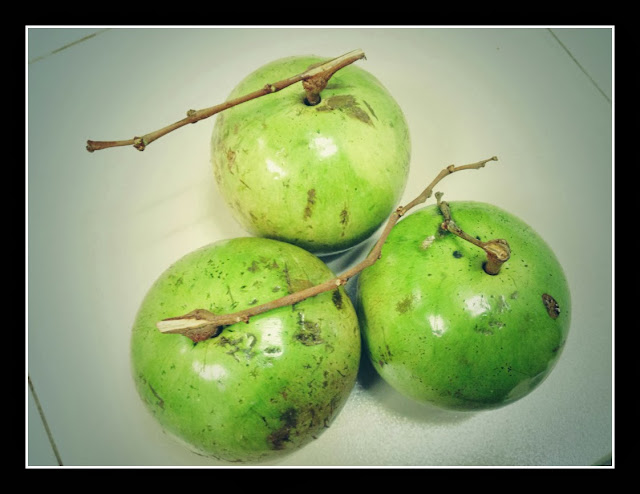တကယ္ဆို စားေနတုန္း မ်က္ႏွာအမူအယာ ဘယ္လိုေျပာင္းလဲသြားတယ္ သိေအာင္ ေလးရိုက္ထားလိုက္ရမွာ။ ခုေတာ့့ ရိုက္ျဖစ္ခဲ့တဲ့ အသီးဓာတ္ပံုေတြပဲ မွတ္ထားလိုက္တယ္။
အသီးက အနီနဲ ့ အစိမ္းမ်ိဳးဆိုၿပီး အေရာင္ႏွစ္မ်ိဳးရွိတယ္ေျပာတယ္။ ခုစားၾကည့္တာကေတာ့ အစိမ္းေရာင္ အသီးမ်ိဳး။
 |
| From StarApple |
ပံုၾကည့္ၿပီးေတာ့ အခြံမာ အသီးလို ထင္တာ မဟုတ္ဘူး။ ကိုင္ၾကည့္ေတာ့ အခြံက ခပ္ေပ်ာ့ေပ်ာ့ပဲ။ အထဲက အသားကလည္း ခပ္ေပ်ာ့ေပ်ာ့ဆိုေတာ့ အသီးကို သရက္သီးစတဲ့တျခားအသီးေတြစားသလို အခြံႏြာၿပီး စားေလ့မရွိဘူး ေျပာတယ္။ ဘယ္လိုစားေလ့ရွိၾကလည္းဆို အသီးကို ႏွစ္ျခမ္းခြဲၿပီး ဇြန္းနဲ ့ျခစ္စားတယ္။ ဒါမွမဟုတ္ ေလးစိတ္စိတ္ၿပီး အထဲက အစားကို ကိုက္စားတယ္။ ေရွာက္ခ်ိဳသီး စားသလိုမ်ဳိး။ အခြံ မစားရဘူး။
ႏွစ္မ်ိဳးလံုး စားၾကည့္ျဖစ္တယ္။ ႏွစ္ျခမ္းျခမ္းၿပီး ဇြန္းနဲ ့ ခပ္စားရတာကို ပိုၾကိဳက္တယ္။ စားလည္းၿပီးေတာ့ အခြံက ခြက္ေလးပံုစံ က်န္ခဲ့တယ္။
 |
| From StarApple |
အရသာက ခ်ိဳတယ္။ ကြၽန္မ အတြက္ေတာ့ အဲ့ဒီအသီးအရသာက ၾသဇာသီး အရသာနဲ ့ ဆင္တယ္ ခံစား ရတယ္။ အျဖဴေရာင္ အေစးေနရာစားမိရင္ နည္းနည္း ဖန္တယ္။ တျခား သူေတြ ကေတာ့ ၾကိဳက္ၾကတယ္။ စားေကာင္းတယ္လို ့ ေျပာတယ္။
အေစ့ယူၿပီး အပင္စိုက္ၾကည့္ရင္ေကာင္းမလား စိတ္ကူးမိၾကတယ္။ ဒီႏိုင္ငံမွာ အဲဒီစိတ္ကူး အေကာင္အထည္ေဖာ္ဖို ့ဆိုတာမျဖစ္ႏိုင္ပါဘူး။ ရန္ကုန္မွာဆိုရင္ေတာ့ အေစ့ကို ပ်ိဳးထားျဖစ္မွာ ေသခ်ာတယ္။
 |
| From StarApple |
Reference:
YouTube မွာေတြ ့တဲ့ Star Apple ဘယ္လို စားရလဲဆိုတာ How to Eat A Star Apple by Big Island Farm Fresh Foods
ဗီယက္နမ္ေတြ ေျပာေလ့ရွိတဲ့ Vú Sữa အေၾကာင္း Vú Sữa-Milky fruit-a thoughtful story
Wiki: မွာေတြ ့ရတဲ့ အခ်က္အလက္ေတြ Chrysophyllum cainito
Scientific Name:Chrysophyllum cainito
Common Names: Star Apple, Vú Sữa (Vietnam), Swarnapathry(Malayalam), Golden-leaf tree (English), Caimito, Estrella, Caimo morado, Caimito maduraverde, (Spanish), Cainito, Ajara (Portuguese), Caimite, Caimitier (French)
Family: Sapotaceae
Relatives of Caimito: mamey sapote, green sapote, abiu, and canistel.
Origin: West Indies and Central America.
Distribution: Caimito is found throughout the Caribbean Region, Central America, northern South America, Australia, and some countries of Southeast Asia and Africa. History: Caimito was observed growing by Spanish explorers in Peru during the 1500s. Seeds were introduced into Hawaii in 1901 and into Florida around 1887. During the 20th century it was distributed to parts of Asia and Africa.
No comments:
Post a Comment